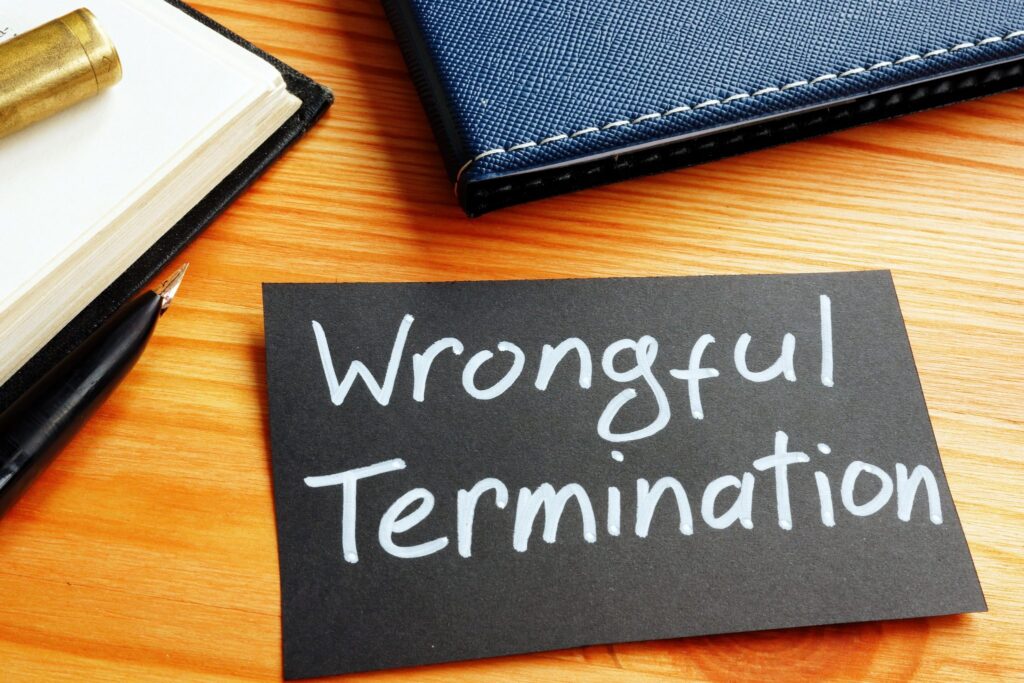If you are wrongfully terminated from a job – or if you were recently fired and want to know how to proceed with your case – this article explains the basics of how to sue for wrongful termination in California.

What is Wrongful Termination in California?
Terminating someone for reasons other than those outlined in their employment contract can be considered wrongful termination. The person terminated may sue for wrongful termination and seek damages such as lost wages and emotional distress damages. A lawsuit against the employer will require two things: a) that the employee had signed a contract saying they are employed at will or b) that the employer hasn’t made an agreement to pay severance money if they are terminated.
Wrongful Termination California Laws
Californians use a number of federal and state laws that keep them from wrongful termination. These include:
• Title VII of the federal Civil Rights Act of 1964
• California Fair Employment and Housing Act (FEHA)
• Age and Discrimination Act (ADEA)
• Equal Pay Act
• Americans with Disabilities Act (ADA)
• California Family Rights Act
• Healthy Workplaces, Healthy Family Act
How to Sue for Wrongful Termination in California
It is important to know how to sue for wrongful termination in California, especially if you were wrongfully terminated and the person who fired you as a public figure. The key point that needs to be proven in your lawsuit is that there was a clear warning on the employee’s contract of his or her rights under the law and that he or she did not have reasonable cause for firing him or her.
There are also specific defenses that should be raised in your defense, such as whether you actually worked out the conditions of your contract, whether or not you were an at-will employee, or whether there were conditions that you agreed to meet while working as a janitor or in other jobs. After you have read the following article, you should have a better understanding of your legal rights and how to proceed with your case.
What Should I Consider Before Pursuing a Wrongful Termination Lawsuit?
Wrongful termination is one of the most common workplace tort claims in the United States. If you believe that you were wrongfully terminated, it is important to consider the following questions before proceeding with the legal process: What type of company am I suing? Where did this happen? Who are my experts? Will my job termination matter be heard in a state or federal court?
If you confirm that you have been unfairly terminated, you should first ask your employer and your employer’s human resources department to write down the exact reason for your termination. If you did not get a correct reason for your termination, you should complain against your employer.
Filing a Complaint
If you were unfairly terminated because of discrimination, your complaint will first be referred to the Equal Employment Opportunity Commission (EEOC). It is a federal body that supervises federal anti-discrimination laws. The EEOC will assign an officer, who is investigating your wrongful termination complaint case.
You can complain against your employer if you believe they acted wrongly by not following through with the laws in California. The DFEH is the state agency that investigates claims of wrongful termination.
The Equal Employment Opportunity Commission (EEOC) and Department of Fair Employment & Housing’s (DFEH) work-share agreement make it possible to file a claim with the appropriate agency. California wrongful termination lawsuits have a lot of strict requirements, making it hard to figure out which organization should file the claim. But if you have one file with one organization and the other is appropriate for your case, they will file it on your behalf.
Wrongful termination of employees is illegal and for you to successfully file a lawsuit, the EEOC or DFEH must determine if warranted. Wrongful termination of employment may involve communication with your employer and arranging a meeting with them, but only if the EEOC or DFEH does not uncover violations. To protect yourself during a wrongful termination lawsuit in California, ensure that you have a Right to Sue letter from the EEOC or DFEH.
These letters allow you to sue your employer for wrongful termination based on age discrimination, race discrimination, national origin discrimination, disability discrimination, gender discrimination, and any other type of bias/protection. Your claims must come with evidence and justifications that the termination was illegitimate.
Proving Your Wrongful Termination Claim in California
Wrongful termination in California can be difficult to prove without sufficient evidence. For example, your right to work relies on certain conditions. You may need specific types of evidence to make your case:-
• Termination letter
• Your agreement
• Emails, notes, files, memos that support your claim
• statements of witnesses
• Personnel file
• Journal of persecution or differentiation
• Copies of complaints if removed as retaliation
Conclusion
Discuss Your Rights with a Lawyer If you feel that you have been wrongfully discharged or have been denied a reasonable accommodation for your disability, then it is advisable to seek the advice of an employment law attorney before you take any action.
If you already have a lawyer, ask them to help you with your case (or review this article and let them know of any questions you have about your case). If you feel that you need to file a claim for unemployment benefits, or that you want to file for your previous hours and wages, get a lawyer’s help.




